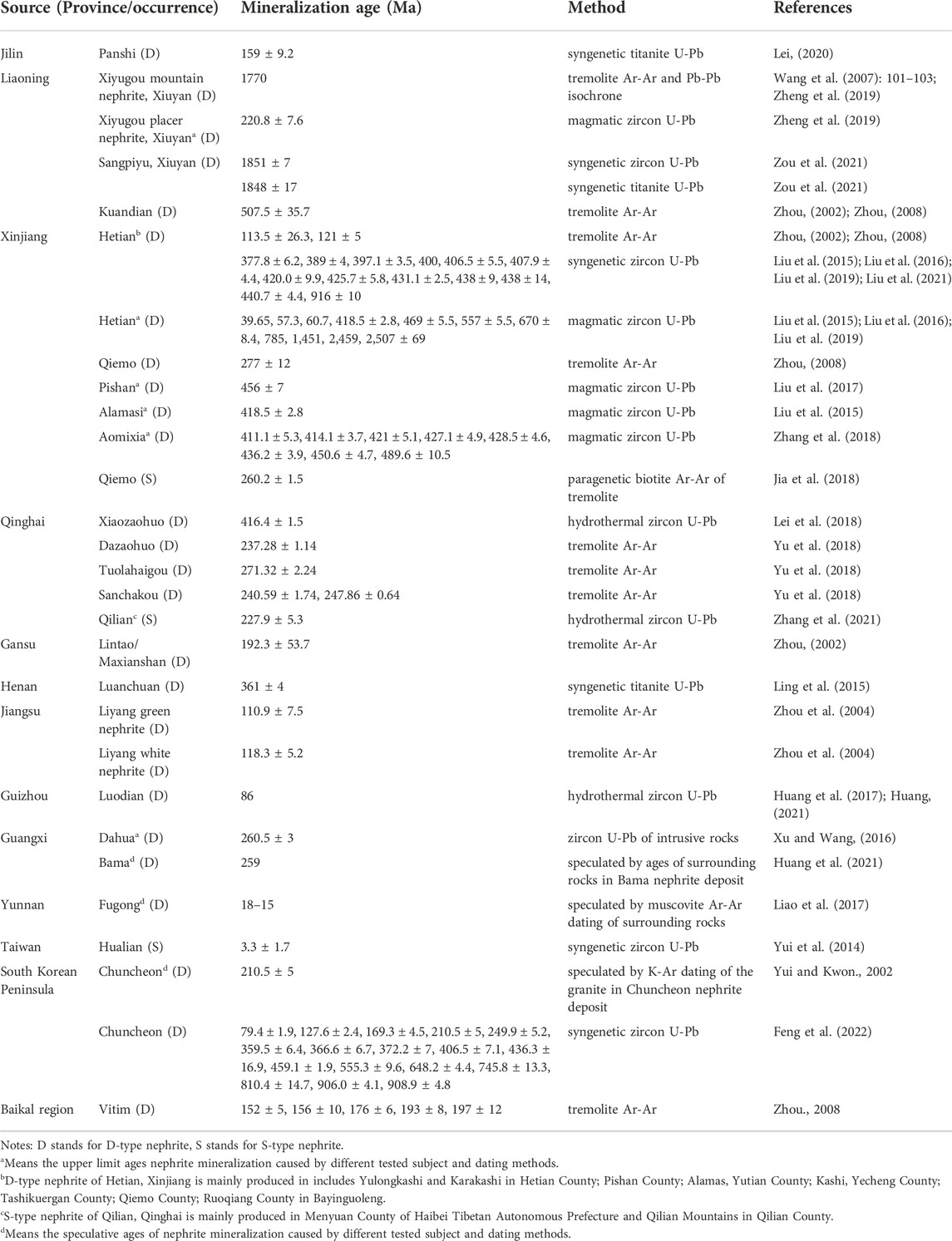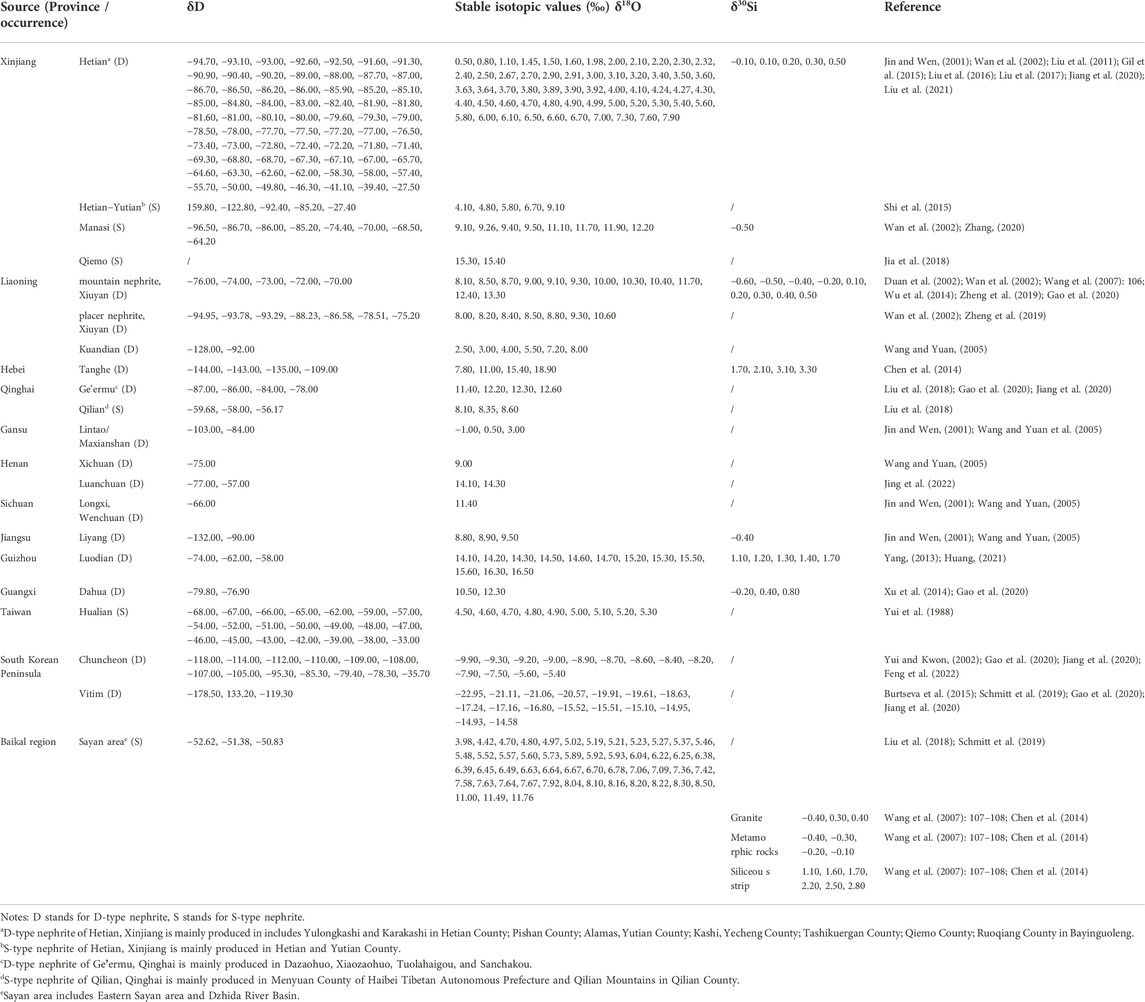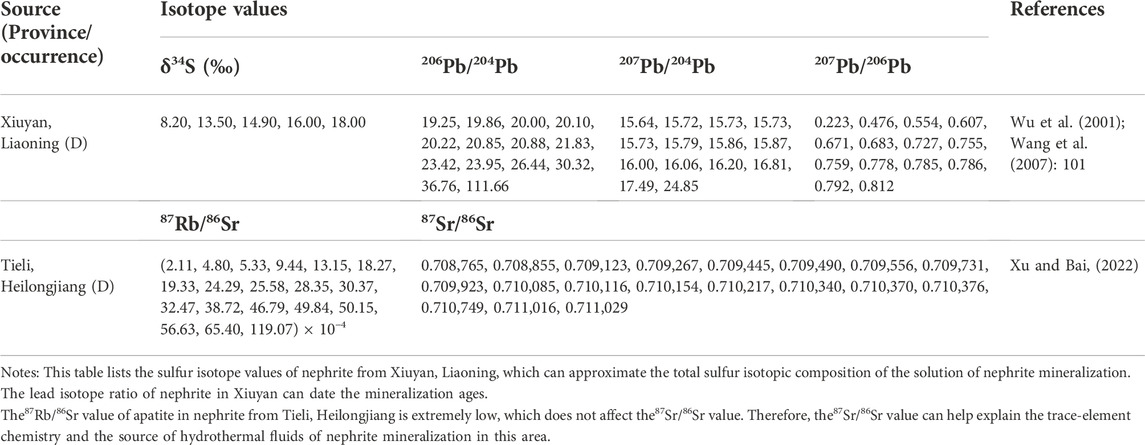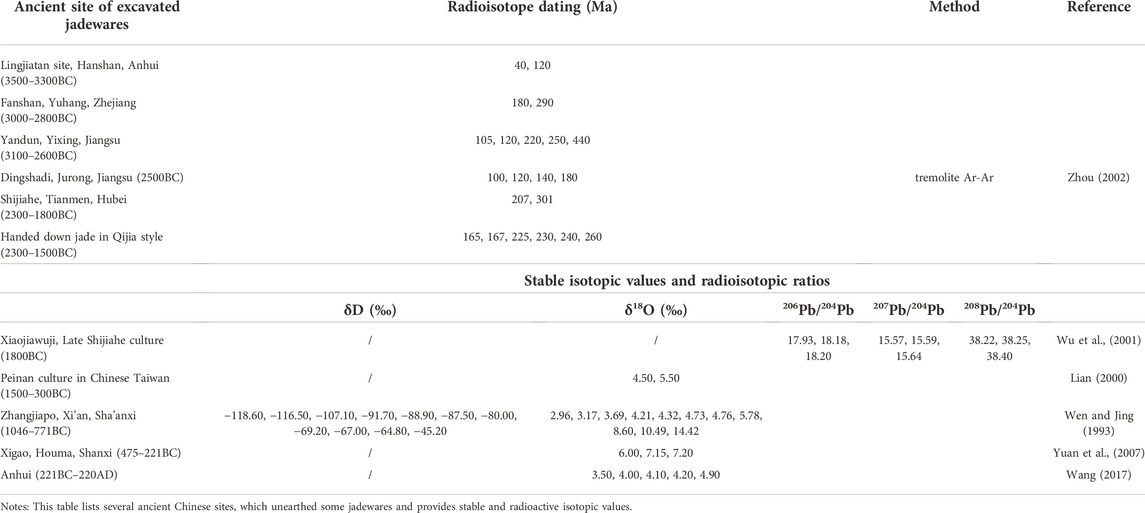- Department of Cultural Heritage and Museology, Fudan University, Shanghai, China
The use of isotopes is crucial for understanding the origin of jade/nephrite. This article first contrasts recent studies on the radioisotopes and stable isotopes of contemporary nephrite deposits in China, Baikal region, and South Korean Peninsula. It then reviews the isotopic analysis of the sources of nephrite artifacts in ancient China, highlighting the concentration of contemporary nephrite deposits with distinct isotopic fingerprints in three significant geographic areas, Northeast Asia, the Yellow River Basin, and South China Region. That is, with regard to Northeast Asia, S-type and D-type nephrite in Baikal region, and D-type nephrite in Chuncheon of South Korea as well as Xiuyan and Kuandian of Liaoning Province can be distinguished well by the radioisotope mineralization age and hydrogen and oxygen isotopic values; with regard to the Upper Yellow River, the isotope method of hydrogen, oxygen and silicon isotopic values has the potential to distinguish the D-type and S-type nephrite in Xinjiang Province and Qinghai Province, while cannot distinguish the D-type nephrite from Hetian, Xinjiang Province and Lintao/Maxianshan, Gansu Province; with regard to South China, the isotope method of the radioisotope mineralization age and hydrogen and oxygen isotopic values has the potential to distinguish D-type nephrite from Fugong in Yunnan Province, Dahua in Guangxi Province and Luodian in Guizhou Province, and S-type nephrite in Hualian, Chinese Taiwan. It is recommended that isotopic database of jade materials from more deposits and excavated jadewares must be established, in order to answer significant archaeological questions regarding the role of jade material utilization in the origin, formation and development of Chinese jade culture and Chinese civilization.
Introduction
Understanding things incorporates identifying, naming and defining, no exception for jade. Concerning the concept of jade artifact, narrow and broad ones are used. The former refers to nephrite (tremolite-actinolite) and jadeite artifact with symbolic significance made through carving and polishing, while the latter refers to precious stone artifact with similar social and technical attributes. It can be seen that both of two definitions focus on the function and processing technique of jadewares, and the difference lies in the scope of materials. The jadeware has been used for 9,000 years and been continuing to this day, which is a significant symbol of traditional Chinese culture (Heilongjiang Provincial Institute of Cultural Relics and Archaeology and Cultural Relic Management Institute of Raohe County, 2019), and there are differences between ancient and modern Chinese jadewares.
Firstly, with regards to the function of Chinese jadewares, modern jadewares are frequently used for adornment to represent the personality of the wearers or to meet their aesthetic needs. Ancient jadewares, however, have multiple functions in order to meet the diverse needs of ancient society and culture (Teng, 2019). Jade culture was either invented or accepted because of its exceptional beauty and sophisticated technology. Due to distinct differences in language, religion, customs and culture, the features of jadewares, such as their material, shape, decoration, carving, function and other details will vary from one region to the next. In addition, jade culture also changed based on social and cultural changes in a particular area.
Secondly, the narrow concept of ancient and modern Chinese jadewares differs. The subject of this study refers to the tremolite-actinolite material, as the general reference to ancient Chinese jadewares and called nephrite in the following (Barnes, 2018). The chemical formula of nephrite is Ca2(Mg,Fe)5 [Si4O11]2(OH)2, where iron and magnesium are in complete isomorphism. When Mg2+/(Mg2++Fe2+) (the iron-magnesium ratio) ≥ 0.9, it can be named as tremolite; when 0.9 > Mg2+/(Mg2++Fe2+) ≥ 0.5, it can be named as actinolite; when Mg2+/(Mg2++Fe2+) < 0.5, it can be named as ferroactinolite (Tang et al., 2006: 77). Thus, it can be seen that tremolite-actinolite is a solid solution formed by tremolite and actinolite minerals. In terms of colour, actinolite minerals often appear green and dark green due to high iron content, while tremolite minerals often appear from cyan, greenish white to white due to low iron content. In terms of structure, the hardness and density of actinolite increases due as iron is substituted (Tang et al., 2006: 109). In terms of geological settings, serpentinized ultrabasic parent rocks with high iron content are prone to form actinolite. The nephrite mineral formed in this process can be called S-type nephrite with very few deposits in China including Hualian in Chinese Taiwan (Yui et al., 1988, 2014), Hetian area (Hetian-Yutian County) (Shi et al., 2015) and Manasi (Wan et al., 2002; Zhang, 2020), as well as Qiemo (Jia et al., 2018) in Xinjiang, Qilian in Qinghai (Zhang, 2006: 381; Liu et al., 2018), Shimian in Sichuan (Xu et al., 2015). In contrast, magnesium-rich metamorphic parent rocks (dolomitic marble) and sedimentary parent rocks (dolomite or lime dolomite) with low iron content are prone to form tremolite, which can be called D-type nephrite. There are many deposits of D-type nephrite in China (Harlow and Sorensen, 2005), and most ancient Chinese jadewares are made of D-type nephrite (Wen and Jing, 1993; Barnes, 2018).
In conclusion, tremolite-actinolite, the primary component of both ancient and contemporary Chinese jadewares, satisfies the desires for ornamentation, ceremonies, medicine, and so on. Since China and its neighbors have many natural resources, it is essential to research the geological origin of ancient Chinese jadewares. This provide key information for answering archaeological questions like how Chinese ancestors exploited jade materials, used tools and skills, and created Chinese jade culture. The background of ancient jadewares reflect various levels of information. For example, background of burial, residence and building sites show the jadewares were used as consumer product, and background of workshop sites and mining sites help comprehend the jade production process and investigate the source of jade raw materials. Since the majority of jadewares were discovered in the first type of background, study of the geological sources of jadeware has been brought into focus. The issue of the origin of jadewares includes two aspects, the geological source of jade and the sites where jadewares were finished, respectively. The geological source of the jadewares reflect the mining knowledge of the ancient people, while production site reflects the processing of jadewares. Different method are applied to study these two aspects. Concerning the production site of jadewares, processing technique combined with type and pattern of jadewares are used for study and three circumstances have been revealed: 1) local production of jadewares with indigenous origin, 2) importing finished products, and 3) local production in imitation of exotic products. Concerning the geological sources of jadewares, scientific and technological techniques are required to provide geological information. Considering nephrite is a limited resource with superior quality, rarity, and attractive appearance, two possible types of mineral material were used: 1) material near the site and 2) material transported over a considerable distance. The difficulty of mining jades raises its worth and repute regardless of the jade source they come from (Pétrequin et al., 2017).
In general, petrographic analysis can determine the texture and mineral composition of nephrite and the generate relationship between tremolite and other minerals, and techniques like electron microprobe and mass spectrometer can be used to determine the characteristics of trace elements, rare earth partition patterns, and isotopes of jade deposits from various origins. Nevertheless, each of these methods has its own limitations, and by combining them, researchers can learn more about the provenance features of jade materials. Among them, the isotopic approach is thought to be a breakthrough. As shown in Figure 1, the current researches of the radioisotope and stable isotope on the nephrite deposits are reviewed in this paper. The region studied includes China and its neighboring Baikal region and South Korean Peninsula. This research is expected to aid future research on the provenance of the ancient jade materials.
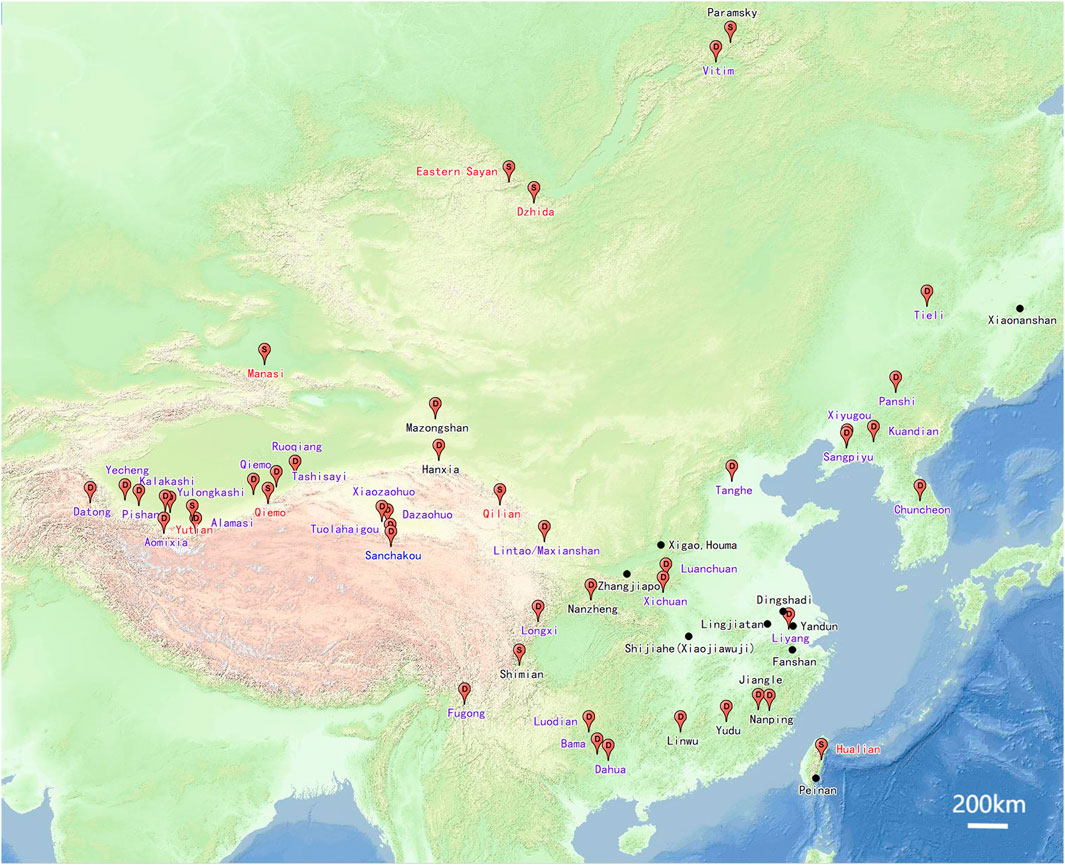
FIGURE 1. Distribution of reported nephrite deposits and the sites where jadewares were excavated in Northeast Asia (D mark with blue word represents D-type nephrite, S mark with red word represents S-type nephrite, D mark or S mark with black word represents the nephrite deposit has no isotopic studies and black dot with black word represents archaeological site mentioned in this article. Ancient jades from Qijia Culture (2300–1500BC) and Anhui Province are not marked because of the unknown sites.)
Analysis of modern nephrite deposits from different regions
At present, the isotopic studies on nephrite formation can be divided into two categories: radioisotopes analysis and stable isotope analysis. The methods include 1) K-Ar or Ar-Ar method, which can directly test the formation age of tremolite (Wang et al., 2007: 101); 2) U-Pb method, indirectly reflecting mineralization age of tremolite formation by determining the age of zircon and titanite (Liu et al., 2016); 3) other isotope methods including using isotopic values of hydrogen, oxygen, silicon and sulfur and isotopic values or isotopic ratios of lead, strontium and iron to trace source of mineralized material and reveal the mineralization hydrothermal types, information on surrounding rock as well as the mechanisms and processes of hydrothermal mineralization (Yu et al., 2018).
Radioisotope dating
K-Ar and Ar-Ar dating
The process of the formation of stable 40Ar isotopes derived from capture of radioactive 40K accompanying the emission of a gamma photon is the foundation of the K-Ar method of geological dating (Wang and Yuan, 2005). The 40Ar-39Ar method is developed on the basis of K-Ar method and overcome the heterogeneous error caused by the determination of potassium and argon content on two samples separately, and analyze the 40Ar-39Ar ratio while activating the sample, thus allowing a more accurate dating of mineralization (Dallmeyer et al., 1997).
For nephrite samples, the K-Ar and Ar-Ar methods are performed on either tremolite-actinolite minerals or alteration minerals in surrounding rocks of the nephrite (Dallmeyer et al., 1997). The accuracy of dating can be affected to some extent by the lower potassium content of tremolite-actinolite minerals and by excess argon or argon loss in nephrite during the metamorphic process. Therefore, tremolite-actinolite should be tested for dating as soon as possible after irradiation, and data correction is required (Zhang, 2020). Some nephrite was formed by the contact metasomatism of the parent rock and the granite. The granite is rich in alteration minerals such as potash feldspar, phlogopite and muscovite with high potassium content, so the age of nephrite mineralization can be indirectly reflected by dating the alteration minerals (Wang and Yuan, 2005). However, the 40Ar-39Ar dating data for alteration minerals tend to be younger, suggesting that there was still hydrothermal activities after nephrite mineralization (Yu et al., 2018). In addition, a few nephrite deposits have been found to yield phlogopite in vein form. However, it is impossible to determine the sequential relationship between phlogopite and nephrite formation, so the age of alteration minerals is also difficult to represent the age of nephrite mineralization (Liu et al., 2017).
In recent years, the development of 40Ar-39Ar dating with the laser microzonation technique allows dating through observing and analyzing tremolite-actinolite or alteration minerals on thin sections. Furthermore, the dating results of cores of nephrite reflect the older age of initial formation and also represent the upper limit of the onset of tectonic activities, while the dating results of edges of nephrite samples may represent the age of the termination of hydrothermal activities. The duration of hydrothermal activities can be revealed by comparing the two ages (Yu et al., 2021).
U-Pb dating
Instruments with great sensitivity and spatial resolution have made in situ microzone analysis possible with the advancement of isotope dating techniques. For instance, when secondary ion mass spectrometry (SIMS) analysis is performed, high-purity oxygen ions are used to first generate secondary ionization in zircon, which is then detected using a sensitive-high-resolution ion microprobe (SHRIMP). Regarding laser inductively coupled plasma mass spectrometry (LA-ICP-MS), a high-energy laser beam is used to bombard zircon. Argon gas then ionizes the exfoliated tiny zircon in a high-temperature plasma. Due to the reliability of age data, U-Pb isotope techniques in zircon are currently widely used (Zhou, 2002; Yu et al., 2021).
Since zircon is not the common paragenetic mineral in nephrite, it is an indirect method to date mineralization ages through zircon and this method often only provides information on when tremolite was formed. Zircon comes in various genetic types, such as magmatic zircon and metamorphic zircon, etc (Wu et al., 2014). U-Pb dating of the magmatic zircon is widely used to date the age of mineralization connected to hydrothermal activities. However, in majority of nephrite produced at low to medium temperatures under conditions of green schist phase, zircons predominantly represent inherited ages, which cannot help properly identify the age of nephrite production. Nevertheless, several methods can help indicate the age of the mineralization of nephrite: 1) The age of zircon in intrusive rocks can indicate an upper limit on the age of nephrite mineralization. And 2) some types of zircon in nephrite can also provide relevant information on the age of mineralization. The zircon in nephrite can be divided into three forms: magmatic rocks, syngenetic zircon, and zircon in late hydrothermal fluids. The first type can be used to determine the upper age limit of nephrite mineralization, while, the age of later two types is close to the mineralization age of nephrite (Zhong, 2000; Wang et al., 2002). For instance, magmatic zircons in S-type nephrite in Hualian, Taiwan, are cut or rimmed by a newly formed zircon that overgrew during the metasomatism of clinozoisite and nephrite-diopsidite. This newly formed zircon in nephrite has a low-temperature hydrothermal thin rim and the U-Pb dating result of its rim is close to the mineralization age of nephrite (Yui et al., 2014). As stated above, in order to precisely date the mineralisation or its upper limit, the origin of zircon and its relationship with nephrite should be ascertained through observing the internal structure of zircon when using U-Pb dating.
In addition, due to its higher closure temperature, titanite is also suitable for U-Pb dating (Frost et al., 2001; Aleinikoff et al., 2002). Since different fluids and melts react with titanite more quickly than they do with zircon, it can retain more age information left in hydrothermal, metamorphic, and other geological processes (Xiang et al., 2007; Sun and Yang, 2009). Theoretically, under the influence of fluids containing silicon and titanium, and at the same pressure and temperature, dolomite can transform into tremolite and titanite (Ling et al., 2015). It can be assumed that tremolite and titanite originated simultaneously when both minerals exhibit incomplete and irregular crystal structures and when tremolite contains metamorphic titanite particles surrounding smaller tremolite inclusions. Thus, titanite is more likely to be coeval with tremolite than zircon, and a correction for its U-Pb age can be translated into a more accurate age of nephrite mineralization (Zhang, 2020).
In summary, U-Pb dating of intrusive rocks and magmatic source zircons represent the upper limit of the age of nephrite mineralization; 40Ar-39Ar dating of tremolite and U-Pb dating of zircon and titanite coeval with tremolite represent the age of nephrite mineralization.
The age of modern nephrite deposits
In terms of structure, components as well as temperature and pressure of formation, the physicochemical characteristics of nephrite from various provenances are highly overlapping; yet, by contrasting these mines, a wide variation of mineralization ages can be observed. Therefore, scholars can differentiate nephrite from different provenances by their mineralization ages. Due to lack of research in this field, a nephrite dating database needs to be established. In this section, the radiometric dating data of modern jade mines in Northeast Asia, such as China, Baikal region and South Korean Peninsula are summarized and showed in Table 1 and Figure 2.
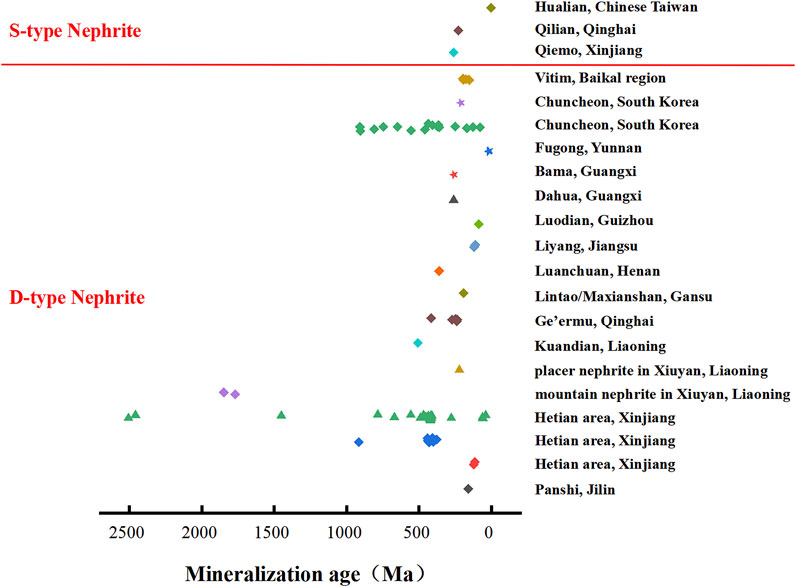
FIGURE 2. Mineralization ages of nephrite deposits in China, South Korean Peninsula and Baikal region. (◆ means mineralization ages of nephrite; ▲ means the upper limit of mineralization ages of the nephrite; ★ means presumed ages of nephrite mineralization. The differences of ages are caused by different tested subject and dating methods, which can be seen in TABLE 1.)
As can be seen from Figure 2, the latest and earliest age of current D-type nephrite deposits in the Hetian area of Xinjiang are 39.65 Ma and 2,507 ± 69 Ma, respectively due to obscure sequential relationship between zircon and tremolite formation analyzed by the Ar-Ar and U-Pb methods (Liu et al., 2015; Liu et al., 2019). The time delta between them can show the time range of nephrite formation and represents multiple phases of geological activities that contributed to various diagenesis and mineralization events (Liu et al., 2019). However, most scholars believe that the age of nephrite formation in Hetian region, Xinjiang is roughly around 400 Ma, which can be used as a fingerprint feature for nephrite from this region (Liu et al., 2015, 2016, 2017; Liu et al., 2019). The mineralization age of primary nephrite deposit from Xiyugou and Sangpiyu in Xiuyan reaches 1770–1851 ± 7 Ma, which can be used as a fingerprint feature for the nephrite from mountains in Liaoning, while the magmatic zircon U-Pb age in the secondary nephrite deposits shows an upper limit of about 220.8 ± 7.6 Ma, indicating that it did not originate from the primary deposits of Xiyugou and Sangpiyu and another source should be considered. The Fugong nephrite deposit from Yunnan has a very young age of 15–18 Ma, which can serve as a fingerprint feature of Yunnan nephrite deposits. The dating results of D-type nephrite deposits from other regions, such as Jilin and Qinghai, with the zircon or titanite U-Pb dating method applied, basically represents the age of tremolite formation, while the dating results of nephrite deposits in Guangxi and Guizhou using magmatic zircon U-Pb method may represent the upper limit of the age of tremolite formation. However, the age of nephrite mineralization in these regions mostly overlap together and cannot be effectively distinguished.
Among S-type nephrite, relevant dating data are scarce, but the mineralization ages of nephrite in Qiemo, Xinjiang (260.2 ± 1.5 Ma) are earlier than that in Qilian, Qinghai (227.9 ± 5.3 Ma), and significantly earlier than that in Hualian, Taiwan (3.3 ± 1.7 Ma). Therefore, they are easily distinguished by their ages.
Stable and radioactive isotope tracer method
Currently, nephrite isotopic studies focus on the application of stable isotopes, such as hydrogen, oxygen, silicon and sulfur, as well as lead and strontium isotope ratios, and the analysis results are summarized in Tables 2, 3.
Application of hydrogen and oxygen isotopes
Hydrothermal studies on nephrite mineralization more frequently employ H-O isotope tracking. There exist two stable isotopes, 1H and 2H (D), and the overall value is represented symbolically by δD. By heating the nephrite sample to 1,000°C to release the hydrogen isotope, the hydrogen isotope will be released and react with Cu2O to create gaseous H2O. After the H2O is cooled, it reacted with zinc at 410°C to produce hydrogen gas. Subsequently, hydrogen isotopic values can be determined by analyzing the hydrogen gas (Liu et al., 2019). The stable isotopes of oxygen include 16O, 17O, and 18O, the overall value of which is represented symbolically by 18O (Wang and Yuan, 2005). Nephrite samples react with BrF5 in a vacuum to release oxygen isotopes, which will subsequently react with graphite at a constant temperature to produce CO2 with platinum as a catalyst. Finally, oxygen isotopic values can be measured by analyzing the CO2 (Wan et al., 2002). Mass spectrometer is often used for isotopic analyses.
H- O isotope tracing of mineralized hydrothermal fluids needs calculations of H-O isotopic values by nephrite mineralization temperature intervals to calculate the values of H-O isotopes and thus identify the source of mineralized hydrothermal fluids (Yui and Kwon, 2002). According to Liu et al. and Gao et al., two methods are typically used to determine the temperature of nephrite mineralization: 1) the first is based on the temperature interval of inclusions in nephrite minerals, such as calcite (250°C in average) (Liu et al., 2011) and pyrite (327°C in average) (Xu et al., 2014), 2) the second is based on the temperature interval of 330–450°C for the mineralization of the skarn (Gao et al., 2020). Graham et al. concluded that although hydrogen isotopic values reflects the temperature of nephrite mineralization and type of mineraliztion solution, the variation of hydrogen isotopic values of nephrite with temperature is very insignificant in the temperature range of 350–650°C. Graham et al. accordingly gave the hydrogen isotope fractionation equation between tremolite and water: 103 lnα = −21.7, which can calculate the hydrogen isotopic value of the mineralization solution (Graham et al., 1984). Based on the incremental approach, Zheng derived the equation for oxygen isotope fractionation between tremolite and water: 103 lnα = 3.95 × 106 × T−2–8.28 × 103 × T−1 + 2.38, which can calculate the δ18O value of the mineralized solution at 350°C (Zheng, 1993).
With regard to S-type nephrite, it can be observed in Figure 3A that the range of hydrogen values for Hualian nephrite is about between −68.00‰ and −33.00‰, which recently can be used as hydrogen isotope reference value for S-type nephrite. The cryptocrystalline to microcrystalline fiber structure of tremolite, which adsorbs some rainwater or river water (Zhang, 2020), are possibly responsible for the lower (−159.80‰ to −70.00‰) and individually higher (−27.40‰) hydrogen isotopes of S-type nephrite from Manasi, Xinjiang, as may be the case for S-type nephrite from Hetian-Yutian, Xinjiang. The hydrogen isotopic values for D-type nephrite, which can be as low as −178.50‰ for Vitim from the Baikal region, cannot be used to distinguish between different origins of D-type nephrite. In addition, the hydrogen isotopic values of S-type nephrite from Baikal region and Qinghai are higher than those of D-type nephrite from the same region, indicating that the hydrogen isotopic values can be used as a fingerprint feature to distinguish S-type and D-type nephrite from these two regions.
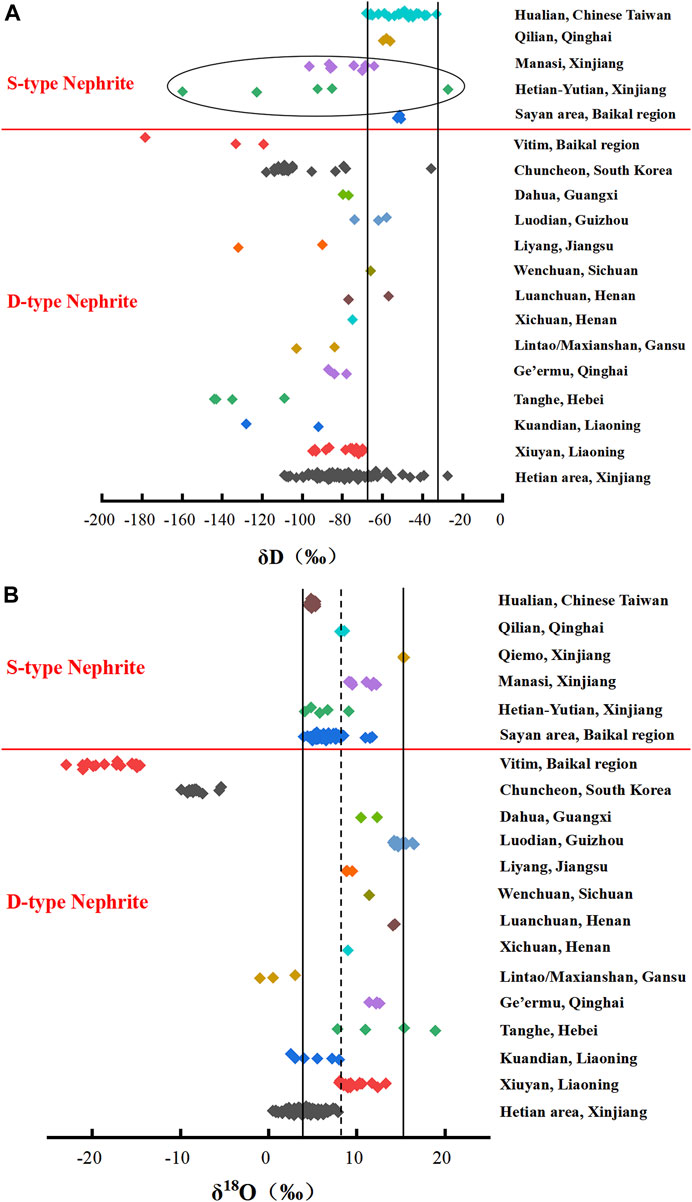
FIGURE 3. Hydrogen and oxygen isotopic values of nephrite deposits in China, Baikal region and South Korean Peninsula (The range of black lines in A represents the hydrogen isotope values of S-type nephrite in Hualian, Qilian and Sayan area, and the ellipse area represents the hydrogen isotope values of S-type nephrit in Xinjiang. The rang of black lines in B represents the oxygen isotope values of S-type nephrite, and the dashed line represents the lower limit of oxygen isotope values of most D-type nephrite.). (A) Hydrogen isotopic values (B) Oxygen isotopic values.
As shown in Figure 3B, it is clear that the oxygen isotopes values of nephrite deposit from Qiemo, Xinjiang are higher than those of other S-type nephrite deposits, while more evidence is needed due to the small sample size. The oxygen isotopic values for D-type nephrite are lowest in Vitim, Baikal region and second lowest in Chuncheon, South Korea. These values are lower than those of other nephrite deposits and can serve as the fingerprint feature of these deposits. Furthermore, as shown in Figures 3, 4, S-type nephrite from the Baikal region and Qinghai have distinct oxygen isotopic values from D-type nephrite in the same area, suggesting that the oxygen isotopic values can be used to distinguish S-type and D-type nephrite from these regions; the oxygen isotopic values of S-type nephrite from Manasi and Qiemo in Xinjiang are higher than those of D-type nephrite from Hetian, Xinjiang, indicating that the oxygen isotopic values can be used as a fingerprint feature to distinguish S-type and D-type nephrite from Xinjiang, except for S-type nephrite from Hetian-Yutian, Xinjiang.
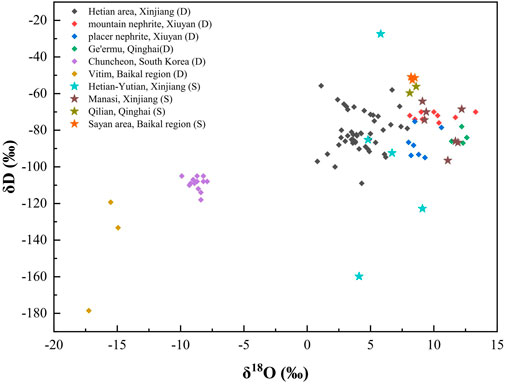
FIGURE 4. Hydrogen and oxygen isotopic values of D-type and S-type nephrite from Xinjiang, Liaoning and Qinghai in China, Chuncheon, South Korea and Baikal region (◆ stands for D-type nephrite; ★ stands for S-type nephrite.).
In addition, hydrogen and oxygen isotopes can help differentiate the jade from mountain (primary) and placer (secondary), as shown in Figure 4. For example, it is generally believed that the placer nephrite (secondary) from the river in Xiuyan of Liaoning Province originates from the mountain nephrite deposit in Xiuyan. However, Zheng et al. pointed out that the value of δ18O and δD from Xiuyan placer nephrite respectively is 8.00‰–10.60‰ and -94.95‰ to −75.20‰, while that of jade from Xiuyan mountain is 8.10‰–13.30‰ and −76.00‰ to −70.00‰ respectively (Wang and Dong, 2011). Obviously, the δD values of Xiuyan placer nephrite (secondary) are significantly lower than those of Xiuyan mountain nephrite (primary). The mineralized fluid of the placer nephrite is mainly derived from magmatic water, whereas the mountain nephrite is mainly derived from regional metamorphic water; therefore the secondary nephrite is not derived from known primary jade material in Xiuyan, and thus it is speculated that there may be undiscovered primary nephrite deposits in the Xiuyan area (Zheng et al., 2019), and the dating data in Table 1 also support this assumption.
Application of silicon isotopes
Silicon has three stable isotopes in nature, 28Si, 29Si and30Si, and the typical test value is expressed as δ30Si. Depending on the values of silicon isotopes, the source of nephrite can be traced. There are two sources of silicon in nephrite, namely intrusive rocks and siliciclastic rocks in surrounding rocks. The source of silicon can be determined by comparing the δ30Si values of nephrite with those of intrusive rocks and siliciclastic rocks in surrounding rocks (Wang et al., 2007: 107-108).
As the Figure 5 shows, current researches on the silicon isotopes of nephrite mainly focus on nephrite from Hetian and Manasi of Xinjiang, Xiuyan of Liaoning, Tanghe of Hebei, Liyang of Jiangsu, Luodian of Guizhou, and Dahua of Guangxi. In general, the silica in nephrite is mainly brought by granite intrusion (Wan et al., 2002). However, the silica in Tanghe nephrite is mainly derived from siliceous strips or nodules in the surrounding rocks of dolomitic marble (Ding et al., 1994: 27–45).
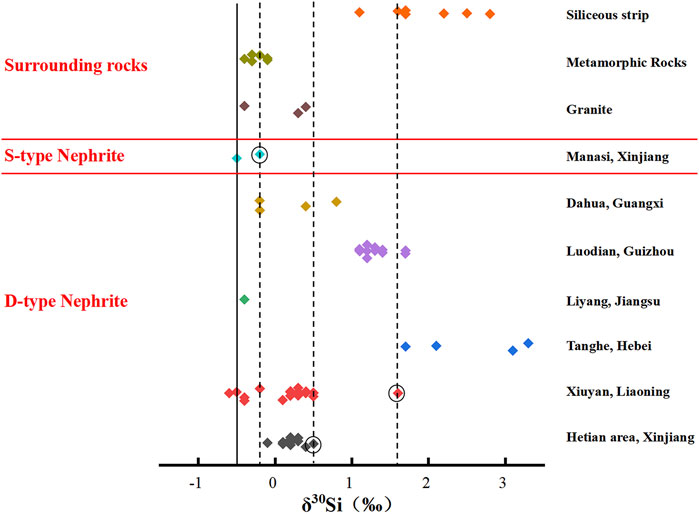
FIGURE 5. Silicon isotopic values of nephrite deposits in China (data in circles are silicon isotopic values of surrounding rocks of nephrite.).
According to Figure 5, in the case of surrounding rocks of the nephrite (dolomite marbles or altered basic volcanic rocks), the silicon isotopic values are generally higher than those of the nephrite itself. Silicon isotopic values for D-type nephrite from Xinjiang are within the range of granitic silica isotopic values, indicating that the silica in the nephrite might come from granitic intrusions at this site (Wan et al., 2002). The silica isotopic values of surrounding rocks of Xiuyan D-type nephrite overlap that of siliceous strips, while the silica isotopic values of the Xiuyan D-type nephrite itself are within the silica isotope range of granite, overlapping with metamorphic rocks, and differing significantly from siliceous bands or nodules, suggesting that the silica in the nephrite is mainly of granite-like or metamorphic hydrothermal origin (Wan et al., 2002; Wang et al., 2007: 107–108) The silica isotopic values of S-type nephrite in Manasi, Xinjiang, are close to those of metamorphic rocks, and are far from siliceous bands or nodules in marble, suggesting that its silica may have no external involvement, but is only related to that in metamorphic rocks (Wan et al., 2002).
Among D-type nephrite, Liyang nephrite has the lowest silicon isotopic value, while only one piece of data is available. The silicon isotopic value of Tanghe nephrite is higher than that of other origins, so the silicon probably comes from siliceous strips. The silicon of Luodian nephrite probably also comes from siliceous strips, because its silicon isotopic value is only lower than that of Tanghe, Hebei, and higher than those of other origins. Thus, silicon isotopes can distinguish D-type nephrite of geographically similar origins like Luodian in Guizhou and Dahua in Guangxi. The silicon isotopic value of Manasi S-type nephrite is at −0.5‰, much lower than that of nephrite from Hetian, Xiuyan and others, reflecting the characteristic of deposit of the metamorphic origin. Consequently, for nephrite deposits in Liyang of Jiangsu, Tanghe of Hebei, Luodian of Guizhou and Dahua of Guangxi, silicon isotopes can therefore be employed as fingerprint features of D-type nephrite. However, due to the lack of data, it remains difficult to discriminate S-type nephrite applying this method.
Application of sulfur isotopes
Coeval pyrite and pyrrhotite are the primary constituent minerals of sulfides in nephrite deposits, so the study on sulfur isotopes mainly focuses on these minerals in nephrite and their sulfur isotopic values (δ34S) can approximate the isotopic composition of total sulfur in the mineralizing solution (Duan and Wang, 2002; Wang et al., 2007: 108). At present, only sulfur isotope of nephrite from Xiuyan in Liaoning have been analyzed, with a relatively wide range of 8.20‰–18.00‰ overlapping the range of sedimentary and metamorphic rocks while quite different from basalt and granite (Wang et al., 2007: 108). Given that the available sulfur isotope analysis data are too few to distinguish different origins of nephrite deposits, further studies are needed.
Application of lead and strontium isotopes
The four different types of lead isotopes in nature are 204Pb,206Pb,207Pb and208Pb, respectively. 204Pb is non-radioactive, while 206Pb,207Pb and208Pb are formed by the natural radioactive decay of 238U, 235U, and 232Th. Studies on lead isotope are scarce. Wu et al. analyzed lead isotopes in two nephrite pieces with values of 30.32 and 36.76 for 206Pb/204Pb and 0.476 and 0.554 for 207Pb/206Pb, respectively, both of which are highly radiogenic lead (Wu et al., 2001). Wang et al. analyzed 12 pieces of Xiuyan nephrite for lead isotopes. One piece had unusually high Pb isotope ratios of 111.66, 24.85, 43.98, and 0.223 for 206Pb/204Pb, 207Pb/204Pb, 208Pb/204Pb, and 207Pb/206Pb, respectively; the remaining 11 pieces have values of 206Pb/204Pb in the range of 19.25–26.44 and 207Pb/206Pb in the range of 0.607–0.812, all of which are of high radiogenic lead. This characteristic of lead isotope is derived from continuous decay of new introduced uranium and thorium since the formation of Xiuyan nephrite. This type of high radiogenic lead can also be used for U-Th-Pb dating and the mineralization age of 1770 Ma is the result of one such practice. (Wang et al., 2007: 101–103).
Strontium has four isotopes in nature, 84Sr, 86Sr, 87Sr, and 88Sr, of which 87Sr is derived from radioactive decay of 87Rb, while 84Sr,86Sr, and 88Sr are stable isotopes (Shi et al., 2012). Different geological bodies have different enrichment capacity for rubidium and strontium, and will have different initial values of 87Sr/86Sr, which can help trace the origin of materials, crust-mantle material evolution and crust-mantle interaction, and thus identify the origin of nephrite and other materials. According to the current studies, D-type nephrite in Poland contains about 3–4 ppm strontium with an initial 87Sr/86Sr ratio of 0.7085. The strontium content might be derived from dolomitic marble (about 90 ppm strontium with an initial 87Sr/86Sr ratio of 0.7081), or from a syngenetic and late granitic intrusions that occurred around 340 Ma (about 400–440 ppm strontium), or from a post tectonic granite intrusions that occurred around 305 Ma (about 86.4 ppm strontium) (Gil et al., 2015). Additionally, Xu and Bai acknowledged that strontium isotopes could aid researchers in tracing the origin of nephrite mineralizing hydrothermal fluids at the site in their investigation of apatite in the Tieli nephrite deposit in Heilongjiang, China. They proposed that the values of 87Sr/86Sr in apatite and the positive correlation between it and strontium content may suggest the contribution of crustal and mantle materials to mineralization. Furthermore, Pacific plate subduction also serves as a source of material and energy for magmatism and mineralization in the Tieli nephrite deposit (Xu and Bai, 2022). Since there are so few relevant researches of other nephrite deposits available, more work is needed to evaluate the feasibility of employing the strontium isotope ratio for the provenance of jadewares.
Research on ancient jadewares
Radioisotope analysis of excavated jadewares
The current researches on the mineralization ages of jadewares excavated from sites in Lingjiatan, Hanshan, Anhui (3,500–3300 BC), Fanshan Cemetery in Yuhang, Zhejiang (3,000–2800 BC), Yandun in Yixing, Jiangsu (3,100–2600 BC), Dingshadi in Jurong, Jiangsu (2500 BC), and Shijiahe, Tianmen in Hubei (2,300–1800 BC) are shown in Table 4.
The composition analysis of the excavated jadewares reveals that they all belong to D-type nephrite (Zhou, 2002). Figure 6 depicts the mineralization age of the excavated jadewares, which is close to that of contemporary nephrite deposits. Therefore, it is hard to ascertain the provenance of these jadewares with accuracy. However, it is evident that the mineralization age of the raw material used to make jadewares in Fanshan, Zhejiang Province (3,000–2800 BC) does not correlate with that of nephrite deposits in Liyang, Jiangsu Province, demonstrating that the raw materials for Fanshan jadewares do not originate from Liyang. Additionally, the mineralization age of jadewares in Yandun and Dingshadi, Jiangsu Province overlapped with that of nearby nephrite deposits in Liyang, suggesting that the raw materials of jadewares found in these two sites may originate from Liyang; and the mineralization age of one piece of handed-down jadeware in Qijia style (2,300–1500 BC) coincides with that of the nephrite deposit in Lintao/Maxianshan, Gansu Province, raising the possibility that the raw material of Qijia jadeware may originate from Lintao/Maxianshan.
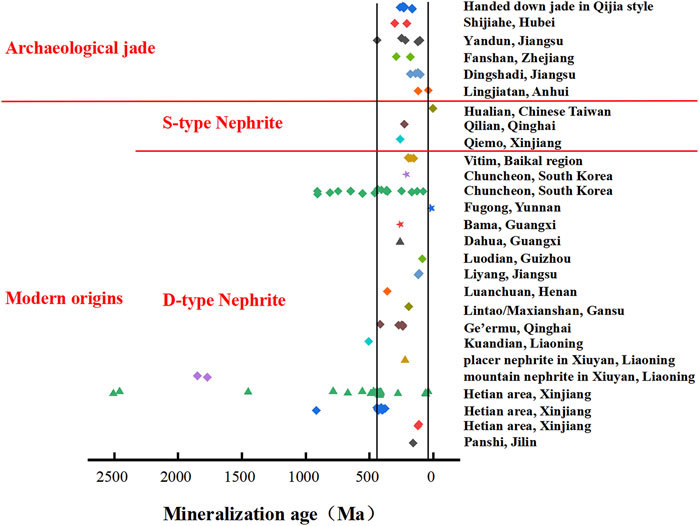
FIGURE 6. Comparative radioisotope analysis of mineralization ages of modern nephrite deposits and excavated jadewares (◆ means mineralization ages of nephrite; ▲ means the upper limit of mineralization ages of the nephrite; ★ means presumed ages of nephrite mineralization. The differences of ages is caused by different tested subject and dating methods, which can be seen in Tables 1, 4. The range of black lines represents the mineralization ages of excavated jadewares.).
Stable isotope analysis of excavated jadewares
Hydrogen isotope analysis
Few stable isotopic researches on unearthed jadewares has been made, while individual researchers have looked into the hydrogen isotopes. Hydrogen isotope analysis was performed on 11 pieces of jadewares unearthed in Zhangjiapo, Sha’anxi Province (1,046–771 BC) which are in the forms of tomahawk, fish and fragments (Wen and Jing, 1993). Figure 7 demonstrates that the results, largely within the hydrogen isotopic values range of D-type nephrite in Northeast Asia, have minimal similarity with hydrogen isotopic values of S-type nephrite. The results in Table 4 reveal that hydrogen isotopic values vary from −118.60‰ to −45.20‰ (Wen and Jing, 1993). Additionally, Figure 7 shows that hydrogen isotopic values cannot confirm the origin of the raw materials of jadewares in Zhangjiapo, and combinative information of other stable isotopes or trace elements is needed for further study.
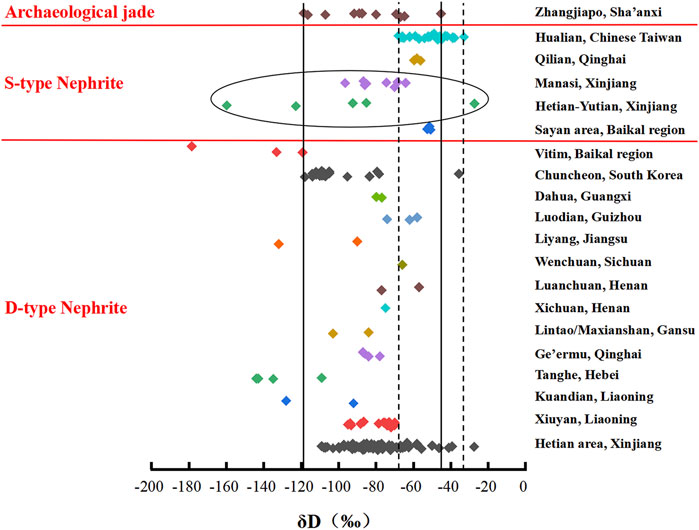
FIGURE 7. Comparative analysis of hydrogen isotopes between modern nephrite deposits and excavated nephrite jadewares (The range of black lines represents the hydrogen isotope values of excavated jadewares, and the ellipse area represents the hydrogen isotope values of S-type nephrite in Xinjiang, as well as the dashed line represents the oxygen isotope values of S-type nephrite in Hualian, Qilian and Sayan area.).
Oxygen isotope analysis
Compared to the hydrogen isotope analysis, more oxygen isotope analyses have been performed on excavated jadewares. For instance, Lian selected 6 pieces of jadewares from Peinan culture (1,500–300 BC) in Taiwan to conduct oxygen isotope analysis. The results in Table 4 show that the oxygen isotopic values ranged from 4.50‰ to 5.50‰, which are extremely close to those of S-type nephrite (4.50‰–5.30‰) in Fengtian, Hualian (Lian, 2000).
Wen and Jing have performed oxygen isotopic analysis on the same samples from Zhangjiapo mentioned above. The results in Table 4 show that the oxygen isotopic values range from 2.96‰ to 14.42‰ (Wen and Jing, 1993). According to petrographic and mineral analysis, these jadewares belong to D-type nephrite (Wen and Jing, 1993), and has a wide range of raw material sources. As shown in Figure 8, the oxygen isotopic values of some Zhangjiapo jadewares are close to those of Hetian in Xinjiang and Kuandian in Liaoning. In the contrast, the hydrogen isotopic values of these three areas are overlapping, indicating that the hydrogen isotopic values may not be as suitable as oxygen isotopic values in the discrimination of provenance.
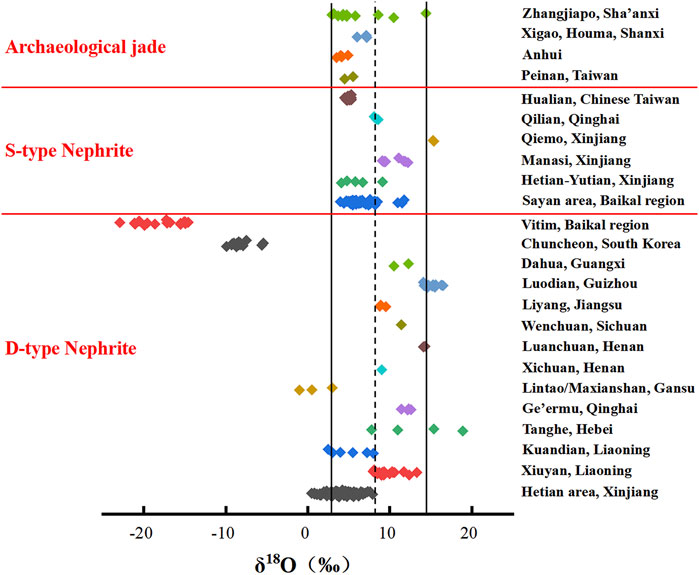
FIGURE 8. Comparative analysis of oxygen isotopes between modern nephrite deposits and excavated jadewares (The range of black lines represents the oxygen isotope values of excavated jadewares, and the dashed line represents the lower limit of oxygen isotope values of most D-type nephrite.).
Yuan et al. analyzed the oxygen isotope of 3 jadewares excavated in Xigao, Houma, Shanxi Province and the Eastern Zhou sacrificial site (770–221 BC) in Jintian Thermal Power Company. The results were 7.20, 6.00, and 7.15 for the numbers Xigao J580 and J332, and the Thermal Power Company JK728, respectively (Yuan et al., 2007). The petrographic examination shows the raw materials of jadewares all belong to D-type nephrite. As shown in Table 4, the oxygen isotope ratios of these jadewares are more similar to those of the Hetian area in Xinjiang and Kuandian in Liaoning.
Wang analyzed the chemical composition and oxygen isotope of 6 ancient jadewares from Anhui Province, and the content of FeO is 0.10%–1.93%, the content of chromium is less than 6 ppm and the content of nickel is less than 3 ppm, which shows they belong to D-type nephrite (Wang, 2017). The results in Table 4 show that the oxygen isotopic values of Anhui jade materials are more similar to those of Hetian area in Xinjiang. Based on the characteristics of trace elements and the distribution curve of rare earth elements, the author believes that the raw materials of 6 jadewares were originated from Hetian, Xinjiang.
Figure 8 represents oxygen isotopic values of both present nephrite deposits and excavated jadewares. According to the studies indicated above, the raw materials of jadewares from Peinan Culture originate from the nephrite deposit in Fengtian, Hualian (Hung, 2014). The raw materials of jadewares in Sha’anxi, Shanxi, and Anhui Province are thought to originate from Hetian, Xinjiang, different from deposits in Baikal region and South Korea. However, according to the section ‘Application of Hydrogen and Oxygen Isotopes’, the data of the oxygen isotopic values of nephrite deposits in Lintao/Maxianshan, Gansu Province are scarce, and there are significant similarities between Hetian, Xinjiang and Lintao/Maxianshan, Gansu in all of mineralization age, hydrogen and oxygen isotopic values. Therefore, it is not reliable to confirm its origin from Hetian, Xinjiang simply by isotope analysis.
Lead isotope analysis
There is little work on the lead isotopic analysis of excavated jadewares. Only Wu et al. analyzed the lead isotope ratios of 5 jadewares excavated from Xiaojiawuji site (1800 BC), Hubei Province, and three of them are nephrite. The results in TABLE 4 show that the ratios of 206Pb/204Pb range from 17.93 to 18.20, 207Pb/204Pb are concentrated around from 15.57 to 15.64, and 208Pb/204Pb range from 38.22 to 38.40. This relatively concentrated distribution of data suggests that the nephrite may originate from the same source. The contents of iron oxide, cobalt, nickel and chromium in three nephrite respectively are 0.2%–0.3%, 19.26–30.31 ppm, 47.14–82.49 ppm and 75.58–1,209 ppm, respectively. Therefore, it can be inferred that they all belong to D-type nephrite (Wu et al., 2001).
Some scholars speculate that the raw materials of Xiaojiawuji jadewares may originate from deposits in Xiuyan, Liaoning Province. The lead isotopic values of jadewares in Xiaojiawuji, Hubei in Table 4, and those of nephrite deposits of Xiuyan, Liaoning in Table 3 are plotted together as Figure 9, and the results contradict the hypothesis.
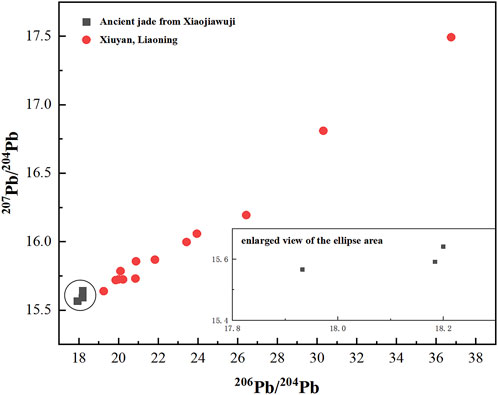
FIGURE 9. Comparative analysis on lead isotopes of excavated jadewares between Xiuyan, Liaoning Province and Xiaojiawuji, Hubei Province.
Disscussion and conclusion
Current researches on lead, strontium, and sulfur isotopes are insufficient to provide fingerprint information for a specific provenance. The radioactive isotopic and stable isotopic characteristics of some nephrite deposits are summarized and shown in Table 5.
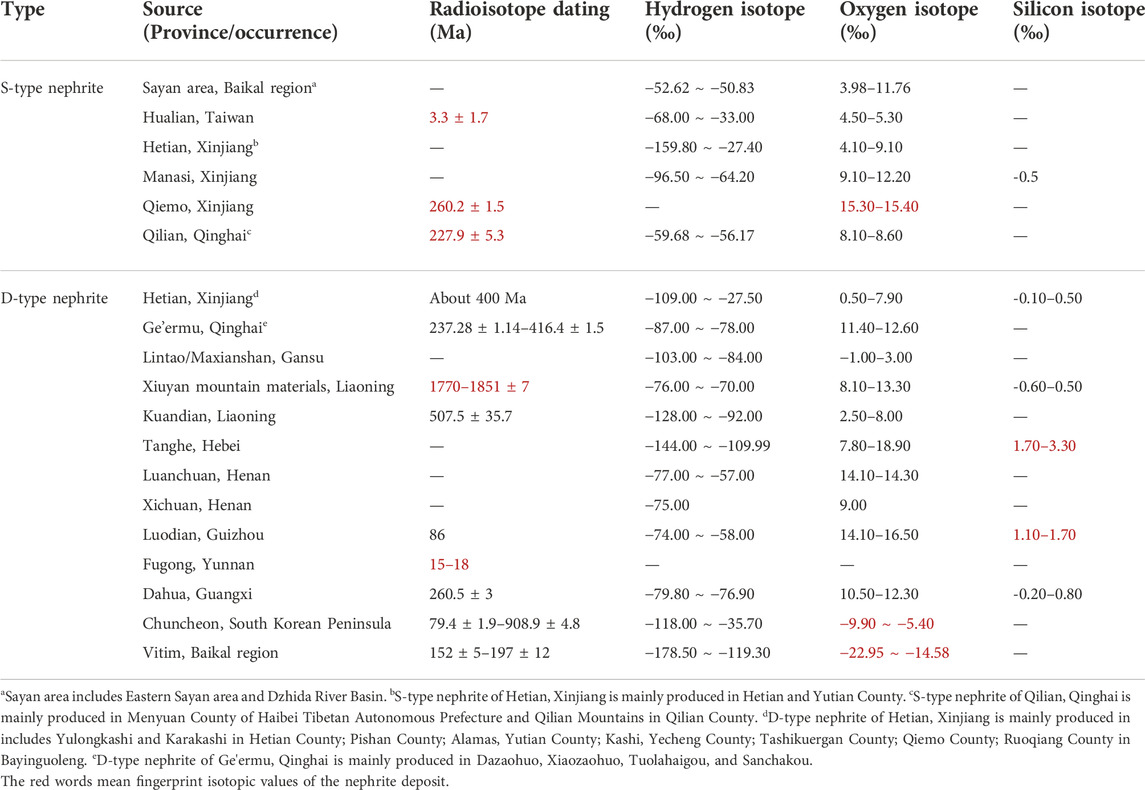
TABLE 5. Isotopic values of nephrite deposits in Northeast Aisa, Yellow River Basin and South China.
Table 5 demonstrates that the nephrite deposits with fingerprint isotopic values are concentrated in three regions: Northeast Asia, Yellow River Basin and South China. Among these regions, Northeast Asia have the most abundant and diverse nephrite deposits, with the S-type nephrite of Eastern Sayan and Dzhida in Baikal region, and the D-type nephrite of Vitim in Baikal region, Xiuyan in Liaoning and Chuncheon in South Korea, occupying most of contemporary nephrite deposits.
Northeast Asia
Current radioisotope dating shows that the mineralization age of D-type nephrite in Xiuyan, Liaoning is the oldest, reaching 1770–1851 ± 7 Ma. With regard to hydrogen isotopic values, the hydrogen isotopic value of D-type nephrite in Vitim, Baikal region is generally smaller than that of D-type nephrite in Chuncheon, South Korea. The value of S-type nephrite in Eastern Sayan and Dzhida, Baikal region is higher than that of indigenous D-nephrite. With regard to oxygen isotopic values, the oxygen isotopic value of D-type nephrite in Vitim, Baikal region is generally smaller than that of D-type nephrite in Chuncheon, South Korea, both significantly lower than other nephrite deposits. The oxygen isotopic value of S-type nephrite in Eastern Sayan and Dzhida, Baikal region is higher than those of D-type nephrite in Vitim, while the value of D-type nephrite in Kuandian, Liaoning is lower than that of D-type nephrite in Xiuyan, Liaoning. Therefore, S-type and D-type nephrite in Baikal region, Chuncheon in South Korea, Xiuyan and Kuandian in Liaoning Province can be distinguished well by isotope analysis.
At present, the earliest jadeware (nephrite) in China was excavated at Xiaonanshan site in Raohe County, Heilongjiang Province, dated from about 9, 200 to 8, 600 years ago. Xiaonanshan culture is regarded as the earliest mature jade culture in the world (Heilongjiang Provincial Institute of Cultural Relics and Archaeology and Cultural Relic Management Institute of Raohe County, 2019). In terms of geographical characteristics, the Sanjiang Plain, where the Xiaonanshan site is situated, is a geographical junction of the Western Pacific coast and the Eurasian steppe. In terms of chronology, the use history of jade in Baikal region is as early as 24,000 years ago (Derevanko et al., 1998: 126–129), significantly earlier than that of Xiaonanshan jadeware in Heilongjiang Province. Therefore, the relationship between Baikal region and Northeast China, that is, whether there is a transmission route of jade culture between Baikal region and Northeast China, has always been an important academic issue. The derivative question is: in what form the jade culture was transmitted if such a route existed? Given a small quantity of jadewares excavated in Baikal region, there is little possibility that jadeware was transmitted directly. Some scholars believe that the jade culture of Baikal region spreads in the form of radiative diffusion of jadeware technology in jade cultural circle (Sergei, 1998). In the process, it spreads to the northeast of China in the southeast. However, the raw material sources of jadeware may be different in these two regions. The ‘nearby theory’ of jade sources states that the raw materials of jadewares in Xiaonanshan could have originated from Tieli, Panshi, Kuandian, Xiuyan, and other deposits nearby. Other scholars contend only jade materials were transmitted, which were mined in Baikal region, delivered to Northeast China via specific routes and subsequently processed into jadewares in Xiaonanshan. The finished jadewares were subsequently distributed to the adjacent areas and then put into use. This hypothesis is known as the ‘long-distance theory’ of jade sources (Deng, 2002: 196–216). Therefore, isotopic analysis may be the key to ascertaining the source of the earliest jade materials in China. It is also necessary to strengthen the analysis of nephrite deposits in Tieli, Heilongjiang Province, that in Panshi, Jilin Province, and that in Paramsky, Baikal region, so as to enlarge the jade database in Northeast Asia.
Yellow River Basin
With regard to the researches of jade sources in the Yellow River Basin, no ancient mining sites have been found in Tanghe nephrite deposits, Hebei Province in the Lower Yellow River. However, the silicon isotopic values of Tanghe is the highest among all nephrite deposits, which could serve as its fingerprint features. In Middle Yellow River, the oxygen isotopic values of D-type nephrite in Luanchuan, Henan Province are higher than those in Xichuan, Henan Province. In Upper Yellow River, the mineralization age of D-type nephrite in Hetian, Xinjiang is 400 Ma, while that of S-type nephrite in Qiemo, Xinjiang is 260.2 ± 1.5 Ma. The mineralization age of S-type nephrite in Qilian, Qinghai is 227.9 ± 5.3 Ma. The hydrogen isotopic value of S-type nephrite in Qinghai is higher than that of D-type nephrite in this area, while the value of S-type nephrite in Manasi, Xinjiang is lower than that of S-type nephrite in Qinghai. The oxygen isotopic value of S-type nephrite in Manasi and Qiemo, Xinjiang is higher than that of D-type nephrite in Xinjiang, while the value of S-type nephrite in Qinghai is lower than that of D-type nephrite in this area. In addition, the oxygen isotopic value of D-type nephrite in Hetian, Xinjiang is lower than D-type nephrite in Ge’ermu, Qinghai, while the value of D-type nephrite in Ge’ermu is higher than the adjacent D-type nephrite in Lintao/Maxianshan, Gansu. It can be seen that the isotope method can effectively distinguish the S-type and D-type nephrite in Xinjiang and Qinghai. It can also help differentiate between the S-type nephrite in Manasi, Xinjiang and Qilian, Qinghai, and the D-type nephrite in Hetian, Xinjiang and Ge’ermu, Qinghai, and between the D-type nephrite in the adjacent Lintao/Maxianshan, Gansu and Ge’ermu, Qinghai, while can not distinguish the D-type nephrite from Hetian, Xinjiang and Lintao/Maxianshan, Gansu.
Current researches focus on the use of jade in Gansu in the Upper Yellow River and the eastern transmission of jade raw material from Hetian, Xinjiang Province. Due to the discovery of Hanxia nephrite deposit in northern Gansu (first mined 4,000 years ago) and Mazongshan nephrite deposit (first mined 3,000 years ago, mainly mined from the Warring States period to the Western Han Dynasty, about 400–100 BC), the early nephrite mining history in the Hexi corridor from 2000 BC to 100 BC become more clear. It went through a number of significant stages (Chen and Yang, 2021) including Xichengyi or Qijia Culture (2000–1700 BC, using jade material from Hanxia deposit), Siba culture or Qijia Culture (1700–1300 BC, no direct evidence of mining), early period of Shanma culture (800–400 BC, using jade material from Hanxia deposit), late period of Shanma culture or Han culture in Central Plains (400–100 BC, using jade material from Mazongshan deposit and Hanxia deposit). In addition, Lintao/Maxianshan nephrite deposit in Lintao/Maxianshan, eastern Gansu Province may be one of the important sources of Qijia jade material (Zhang et al., 2018). It is possible that jade material from northern Gansu spread eastward to Shanxi Province, and was used by the Xiajin ancestors in the south of Shanxi until the Han Dynasty, such as some jadewares unearthed from the Shizishan tombs of the Western Han Dynasty in Xuzhou (Qiu et al., 2020). It is noteworthy that the nephrite from Hetian in Xinjiang was thought to be used in Central Plain as early as Shang Dynasty. However, the time of the eastward spread of Hetian nephrite has been reconsidered because the early use of Gansu jade material was realized (Institute of ArchaeologyChinese Academy of Social Sciences, 1982: 11). Table 4 shows that the oxygen isotopic values of jadewares excavated in Sha’anxi and Shanxi Province during the Zhou period are similar, close to those of D-type nephrite in Kuandian, Liaoning and Hetian, Xinjiang, but there is a certain difference with the D-type nephrite in Lintao/Maxianshan, eastern Gansu. As the isotope data of jade in Lintao/Maxianshan in eastern Gansu Province are very few at present, it is necessary to expand the database, analyze the isotope data of Hanxia nephrite deposit and Mazongshan nephrite deposit in western Gansu Province as well as the Nanzheng nephrite deposit in South Sha’anxi (Dong, 2020), and then study the possible fingerprint characteristics among Xinjiang nephrite, Gansu nephrite, Qinghai nephrite and Sha’anxi nephrite.
South China
With regard to the researches on the source of jade material in South China, Table 1 shows that radioisotope dating can effectively distinguish D-type nephrite from Fugong (15–18 Ma) in Yunnan Province, Dahua (260.5 ± 3 Ma) in Guangxi Province and Luodian (86 Ma) in Guizhou Province, significantly earlier than S-type nephrite (3.3 ± 1.7 Ma) in Hualian, Chinese Taiwan. The hydrogen, oxygen and silicon isotopes values of D-type nephrite in Dahua are all lower than those in Luodian. The oxygen isotopic values of S-type nephrite in Hualian are all lower than those of D-type nephrite in Dahua, Guangxi and Luodian, Guizhou. No ancient mining sites have been found in Luodian in Guizhou, Fugong in Yunnan or Dahua in Guangxi, as well as in some deposits with no isotopic researches such as Linwu in Hunan (Meng, 2019; Hou et al., 2021), Yudu in Jiangxi (Huang and Jiang, 1993), Nanping (Tang et al., 1997) and Jiangle (Zheng and Huang, 1993) in Fujian. Due to the influence of the Lower Yangtze River, the use of jade material from Fengtian in Hualian, Taiwan can date back to 5,000 years ago (Yin, 2019), and had been spread to the Philippine Islands, northern Borneo, central and southern Vietnam, central Cambodia, central Thailand and southern peninsula since 2000 BC (Kuo, 2019). The current researches suggest that this type of transmission can be divided into two stages. The first stage in 2000–500 BC was dominated by the dissemination of finished jadewares in Taiwan, which were probably worn and transferred by Taiwan prehistoric immigrants (Austronesians). The second stage in 500–100 BC is dominated by the export of jade material in Fengtian, Taiwan, which is made into Southeast Asian style jadewares in the import places (Hung, 2019). With the demise of the Peinan site in 300 BC, the cessation of the export of Taiwan nephrite in 100 BC, and the production of beadwork and other ornaments made from metal, glass and carnelian, Taiwan jade entered a period of decline around 0 AD and disappeared in 1000 AD (Bellwood, et al., 2011). This shows that both the dissemination of Taiwan jadewares and the export of Fengtian nephrite involve the determination of the relationship between the jadewares excavated in South China and Southeast Asia and the nephrite deposits in Fengtian, Hualian in Chinese Taiwan, where the radioisotope mineralization age and oxygen isotopic values can be used as a fingerprint feature. Morever, isotopic analysis should be applied in nephrite deposits in Linwu of Hunan Province, Yudu of Jiangxi Province, Nanping and Jiangle of Fujian Province.
In general, the provenance of jade material is the greatest difficulty for science and technology to be involved in jade researches, and the integration of different approaches is the solution. Although the isotope approach has shown great potential in the identification of jade/nephrite deposits in Northeast Asia, the Upper Yellow River and South China, it is still necessary to strengthen the establishment of the database, especially to increase the isotope study on the jade/nephrite deposits in Baikal region (Paramsky), Gansu Province (Mazongshan, Hanxia and Maxianshan), Sha’anxi Province (Nanzheng), Hunan Province (Linwu), Jiangxi Province (Yudu), Fujian Province (Nanping and Jiangle), and to introduce lead, sulfur, strontium and other isotopic values if needed (Lan et al., 2022). In addition, the study on isotopes in the Yangtze River basin also needs to be further carried out. For example, one of the sources of some nephrite objects from the Sanxingdui site (1,200–1,000 BC) and Jinsha site (1,200–600 BC) in the upper reaches of the Yangtze River is believed to originate from the nearby Longxi nephrite deposit (Wang, 2021), while the sources of jade artifacts from the Liangzhu site (3,300–2,300 BC) in the lower reaches of the Yangtze River are still under discussion.
In conclusion, isotope methods still need to be combined with petrographic analysis, trace elements, rare earth elements distribution patterns and other methods. Firstly, D-type and S-type nephrite can be distinguished by trace elements and petrographic test method. Then on this basis, a feasible way to overcome this problem can be provided comprehensively, so as to make the cultural or trade exchange routes clear and clarify the origin, formation, development and other important issues of cross-regional cultures. The conclusions of this paper are obtained based on the existing data and will be updated with the expansion of data. The authors hope that this paper can arouse scholars to pay more attention to the research on the provenance of excavated jadewares in China.
Author contributions
RW designed the idea for the study and wrote the manuscript; XS acquired and interpreted the data as well as wrote the manuscript.
Funding
This research is funded by the Shanghai Philosophy and Social Science Planning Project (Grant number: 2021ZLS001).
Conflict of interest
The authors declare that the research was conducted in the absence of any commercial or financial relationships that could be construed as a potential conflict of interest.
Publisher’s note
All claims expressed in this article are solely those of the authors and do not necessarily represent those of their affiliated organizations, or those of the publisher, the editors and the reviewers. Any product that may be evaluated in this article, or claim that may be made by its manufacturer, is not guaranteed or endorsed by the publisher.
References
Aleinikoff, J. N., Wintsch, R. P., Fanning, C. M., and Dorais, M. J. (2002). U–Pb geochronology of zircon and polygenetic titanite from the glastonbury complex, Connecticut, USA: An integrated SEM, EMPA, TIMS, and SHRIMP study. Chem. Geol. 188 (1-2), 125–147. doi:10.1016/s0009-2541(02)00076-1
Barnes, G. L. (2018). Understanding Chinese jade in a world context. J. Br. Acad. 6, 1–63. doi:10.5871/jba/006.001
Bellwood, P., Hung, H. C., Iizuka, Y., Benitez-Johannot, P., and Aragon, L. V. (2011). “Taiwan jade in the Philippines: 3000 years of trade and long-distance interaction,” in Paths of origins: The austronesian heritage in the collections of the national Museum of the Philippines, the Museum nasional Indonesia, and The Netherlands rijksmuseum voor volkenkunde (Manila, Asia: Art Post Asia), 30–41.
Burtseva, M. V., Ripp, G. S., Posokhov, V. F., and Murzintseva, A. E. (2015). Nephrites of East siberia: Geochemical features and problems of Genesis. Russ. Geol. Geophys. 56 (3), 402–410. doi:10.1016/j.rgg.2015.02.003
Chen, C., Yu, X. J., and Wang, S. Q. (2014). Study on gemmological characteristics and ore Genesis of nephrite from Tanghe, Hebei Province. J. Gems Gemmol. 16 (3), 1–11. in Chinese. doi:10.15964/j.cnki.027jgg.2014.03.001
Chen, G. K., and Yang, Y. S. (2021). Preliminary archaeological observations on early mining activities of the tremolite deposits in the Hexi Corridor. Dunhuang Res. (05), 85–94. (in Chinese).
Dallmeyer, D. R., Kräutner, H. G., and Neubauer, F. (1997). Middle-late triassic 40Ar/39Ar hornblende ages for early intrusions within the Ditrau alkaline massif, Rumania: Implications for Alpine rifting in the Carpathian orogen. Geol. Carpathica 48 (6), 347–352.
Deng, C. (2002). “A little understanding of the origin of jade,” in Collection of Chinese jade culture and jade science (Beijing, China: Forbidden City Press), 196–216. (in Chinese).
Derevanko, A. P., Shimkin, D. B., and Powers, W. R. (1998). The paleolithic of siberia: New discoveries and interpretations. Urbana and Chicago: University of Illinois Press, 126–129.
Ding, T. P., Jiang, S. Y., Wan, D. F., Li, Y. H., and Li, J. C. (1994). Silicon isotope geochemistry. Beijing, China: Geological Publishing House, 27–45. (in Chinese).
Dong, H. N. (2020). A study on the mineralogical characteristics of diorite bearing jades in Hanzhong, Shaanxi Province. Beijing, China: China University of Geosciences. (in Chinese). Master's thesis.
Duan, T. Y., and Wang, S. Q. (2002). Study on stable isotopes of Xiuyan nephrite (tremolite). Acta Petrol. Mineral. 21 (1), 115–119. (in Chinese).
Feng, Y. H., He, X. M., and Jing, Y. T. (2022). A new model for the formation of nephrite deposits: A case study of the Chuncheon nephrite deposit, South Korea. Ore Geol. Rev. 141, 104655. doi:10.1016/j.oregeorev.2021.104655
Frost, B. R., Chamberlain, K. R., and Schumacher, J. C. (2001). Sphene (titanite): Phase relations and role as a geochronometer. Chem. Geol. 172 (1–2), 131–148. doi:10.1016/S0009-2541(00)00240-0
Gao, K., Fang, T., Lu, T. J., Lan, Y., Zhang, Y., Wang, Y. Y., et al. (2020). Hydrogen and oxygen stable isotope ratios of dolomite-related nephrite: Relevance for its geographic origin and geological significance. G&G. 56 (2), 266–280. doi:10.5741/gems.56.2.266
Gil, G., Bagiński, B., Gunia, P., Madej, S., Sachanbiński, M., Jokubauskas, P., et al. (2020). Comparative Fe and Sr isotope study of nephrite deposits hosted in dolomitic marbles and serpentinites from the Sudetes, SW Poland: Implications for Fe-As-Au-bearing skarn formation and post-obduction evolution of the oceanic lithosphere. Ore Geol. Rev. 118, 103335. doi:10.1016/j.oregeorev.2020.103335
Graham, C. M., Harmon, R. S., and Sheppard, S. M. (1984). Experimental hydrogen isotope studies: Hydrogen isotope exchange between amphibole and water. Am. Mineral. 69 (1-2), 128–138.
Harlow, G. E., and Sorensen, S. S. (2005). Jade (nephrite and jadeitite) and serpentinite: Metasomatic connections. Int. Geol. Rev. 47, 113–146. doi:10.2747/0020-6814.47.2.113
Heilongjiang Provincial Institute of Cultural Relics and Archaeology, and Cultural Relic Management Institute of Raohe County (2019). The excavation of zone Ⅲ of the xiaonanshan site in Raohe county, Heilongjiang in 2015. Archaeology 20 (8), 3–20. (in Chinese). doi:10.1515/char-2020-0007
Hou, Z. H., Ye, P., Zeng, S. Q., Li, J., Peng, J., and Guo, M. C. (2021). Preliminary exploration on quality grading system of Linwu tremolite Jade. Hunan Nonferrous Met. 37 (6), 79–82. (in Chinese).
Huang, H. N., and Jiang, B. C. (1993). The applicational study of tremolite in the quick firing tiles at low temperatures. Ceram. Stud. J. 9 (2), 67–75. (in Chinese). doi:10.16649/j.cnki.36-1136/tq.1993.02.004
Huang, Q. X., Wang, S. Q., Liang, G. K., Yang, X. D., and Wu, X. K. (2021). Mineralogical characteristics and Genesis of Bama nephrite. Acta Petrol. Mineral. 5, 977–990. (in Chinese).
Huang, Y., Chen, N. S., Han, Y. P., Bai, L., and Deng, X. J. (2017). Zircon U-Pb dating and its significance of intermediate intrusive rocks within the basic sill in Luodian nephrite deposit, Guizhou Province. Guizhou Geol. 34 (2), 90–96. (in Chinese).
Huang, Y. (2021). Study on genesis of luodian nephrite deposit, Guizhou Province. Wuhan, China: China University of GeosciencesDoctoral dissertation.
Hung, H. C. (2019). Communication between prehistoric peoples in eastern Taiwan and the Philippine archipelago—from the paleolithic to the iron age. Field Archaeol. 19 (2), 87–116. (in Chinese).
Hung, H. C. (2014). “Jade in southeast Asia,” in Encyclopedia of the history of science, technology, and medicine in non-western cultures. Editor H. Selin (Netherlands: Springer Netherlands), 1–8.
Institute of Archaeology, Chinese Academy of Social Sciences (1982). Yin ruins jade. Beijing, China: Heritage Press, 11. (in Chinese).
Jia, Y. H., Liu, X. F., Liu, Y., Zhang, Q. C., Zhang, Y., and Li., Z. J. (2018). Petrogenesis of the serpentinite-related nephrite deposit in Qiemo county, Xinjiang. Acta Petrol. Mineral. 37 (5), 824–838. (in Chinese).
Jiang, Y., Shi, G., Xu, L., and Li, X. (2020). Mineralogy and geochemistry of nephrite jade from yinggelike deposit, altyn tagh (Xinjiang, NW China). Minerals 10 (5), 418. doi:10.3390/min10050418
Jin, S. J., and Wen, G. (2001). “Some characteristics of nephrite stable isotopes,” in Proceedings of the conference on ancient jade studies on both sides of the Taiwan strait (Taipei, China: Taiwan University Publishing Committee), 555. (in Chinese).
Jing, Y. T., Liu, Y., Abuduwayiti, M., and Zhang, Y. (2022). Metallogenic age, formation process and prospecting direction of marble-related nephrite deposit in China. Acta Petrol. Mineral. 41 (3), 651–667. (in Chinese).
Kuo, S. C. (2019). New frontiers in the neolithic archaeology of Taiwan (5600-1800BP): A perspective of maritime cultural interaction. Singapore: Springer Nature.
Lan, Y., Yu, H. Y., Ruan, Q. F., Sha, X., Yi, Z. B., and Yang, Y. F. (2022). Present situation and prospect of tremolite jade metallogenic research. J. Guilin Univ. Technol. 42 (1), 55–62. (in Chinese).
Lei, C., Yang, M. X., and Zhong, Z. Q. (2018). Zircon U-Pb ages and Hf isotopes of the Xiaozaohuo nephrite, eastern kunlun orogenic belt: Constraints on its ore-forming age. Geotect. Metallog. 42 (1), 108–125. (in Chinese). doi:10.16539/j.ddgzyckx.2018.01.009
Lei, J. L. (2020). “The study on geochemistry and mineralization age of nephrite from Panshi, Jilin, southeast China,” (Beijing, China: China University of Geosciences). Master's thesis.
Lian, Z. M. (2000). Research on peinan jade in Taiwan. Palace Mus. J. 01, 18–38+9495. (in Chinese). doi:10.16319/j.cnki.0452-7402.2000.01.003
Liao, C., Xue, C. D., Tang, J., and Yang, Z. C. (2017). The gemological characteristics and Genesis of the Yawuduo tremolite nephrite deposits in Fugong county, Western Yunnan province, China. Contrib. Geol. Mineral. Resour. Res. 32 (2), 236–244. (in Chinese).
Ling, X. X., Schmädicke, E., Li, Q. L., Gose, J., Wu, R. H., Wang, S. Q., et al. (2015). Age determination of nephrite by in-situ SIMS U–Pb dating syngenetic titanite: A case study of the nephrite deposit from luanchuan, henan, China. Lithos 220, 289–299. doi:10.1016/j.lithos.2015.02.019
Liu, X. F., Gil, G., Liu, Y., He, X. M., Syczewski, M., Bagiński, B., et al. (2021). Timing of formation and cause of coloration of Brown nephrite from the tiantai deposit, south altyn tagh, northwestern China. Ore Geol. Rev. 131, 103972. doi:10.1016/j.oregeorev.2020.103972
Liu, X. F., Jia, Y. H., and Liu, Y. (2019). Geochemical charracteristics and genetic types of gobi nephrite in ruoqiang—qiemo, Xinjiang. Rock Mineral Analysis 38 (3), 316–325. doi:10.15898/j.cnki.11-2131/td.201806180072
Liu, X. F., Liu, Y., Li, Z. J., Abuduwayiti, M., Tian, G. Y., and Guo, D. X. (2017). The Genesis and SHRIMP U-Pb zircon dating of the Pishan Brown nephrite-bearing Mg-skarn deposit in Xinjiang. Acta Petrol. Mineral. 36 (2), 259–273. (in Chinese).
Liu, X. F., Zhang, H. Q., Liu, Y., Zhang, Y., Li, Z. J., Zhang, J. H., et al. (2018). Mineralogical characteristics and Genesis of green nephrite from the World. Rock Mineral Analysis 37 (5), 479–489. (in Chinese). doi:10.15898/j.cnki.11-2131/td.201712010187
Liu, Y., Deng, J., Shi, G., Yui, T. F., Zhang, G., Abuduwayiti, M., et al. (2011). Geochemistry and petrology of nephrite from Alamas, Xinjiang, NW China. J. Asian Earth Sci. 42 (3), 440–451. doi:10.1016/j.jseaes.2011.05.012
Liu, Y., Zhang, R. Q., Abuduwayiti, M., Wang, C., Zhang, S., Shen, C., et al. (2016). SHRIMP U–Pb zircon ages, mineral compositions and geochemistry of placer nephrite in the yurungkash and karakash river deposits, west kunlun, Xinjiang, northwest China: Implication for a magnesium skarn. Ore Geol. Rev. 72, 699–727. doi:10.1016/j.oregeorev.2015.08.023
Liu, Y., Zhang, R., Zhang, Z., Shi, G., Zhang, Q., Abuduwayiti, M., et al. (2015). Mineral inclusions and SHRIMP U–Pb dating of zircons from the Alamas nephrite and granodiorite: Implications for the Genesis of a magnesian skarn deposit. Lithos 212, 128–144. doi:10.1016/j.lithos.2014.11.002
Meng, D. Y. (2019). “Gemological study of tremolite jade in Xianghualing area, Hunan Province,” (Hebei, China: Hebei GEO University). Master's thesis.
Pétrequin, P., Pétrequin, M. A., Gauthier, E., and Sheridan, A. (2017). “Alpine jades: From scientific analysis to neolithic know-how,” in The exploitation of raw materials in prehistory: Sourcing, processing and distribution. Editors T. X. Pereira Terradas, and N. Bicho (Cambridge: Cambridge Scholars Publishing), 354–367.
Qiu, Z. L., Zhang, Y. F., Yang, J., Wang, H., Chen, G. K., Li, Y. D., et al. (2020). The ancient jade mine discovered in dunhuang Hanxia of northern Gansu province: A potential important source of jade material in early stage of China. J. Gems Gemmol. 22 (05), 1–12. (in Chinese). doi:10.15964/j.cnki.027jgg.2020.05.001
Schmitt, A. K., Liu, M. C., and Kohl, I. E. (2019). Sensitive and rapid oxygen isotopic analysis of nephrite jade using large-geometry SIMS. J. Anal. At. Spectrom. 34 (3), 561–569. doi:10.1039/c8ja00424b
Sergei, A. K. (1998). “The ancient jades of Asia in the light of investigations by the Russian archaeologists,” in east Asian jade: Symbol of excellenceEast Asian jade. HongKong: Centre for Chinese archaeological art research (Hongkong, China: Chinese University of Hong Kong), 251–279.
Shi, M., Yu, B. S., Guo, Y., Yuan, Y., and Ng, Y., N. (2015). Structural and mineralogical characterization of green nephrite in Hetian, Xinjiang, China. Key Eng. Mat. 633, 159–164. doi:10.4028/www.scientific.net/KEM.633.159
Shi, Z. S., Chen, K. Y., He, H. J., Shi, J., Liu, B. J., and Liu, G. (2012). Application of Sr isotope to sedimentary environment analysis. Oil Gas. Geol. 24 (2), 187–190. (in Chinese). doi:10.11743/ogg20030218
Sun, J. F., and Yang, J. H. (2009). A Review of in-situ U-Pb dating methods for the accessory U-bearing minerals. J. Jilin Univ. Sci. Ed. 39 (4), 630–641. (in Chinese).
Tang, D. P., Lin, G. X., Jiang, A. G., Yu, J. C., and Chen, W. B. (1997). The nephrite first found in Fujian, China. Geol. J. China Univ. 3 (4), 396–399. (in Chinese).
Tang, Y. L., Chen, B. Z., and Jiang, R. H. (2006). China khotan jade. Xinjiang, China: Xinjiang People Publ. House 77, 109, 112. (in Chinese).
Teng, S. P. (2019). “From “East vs west” to “south vs North” - The nine thousand year development and evolution of jade culture,” in Sel. Jades natl. Palace Mus. Ed S. P. Teng (Taipei, China: National Palace Museum, 117–188.
Wan, D. F., Wang, D. P., and Zou, T. R. (2002). Silicon and oxygen isotopic compositions of Hetian jade, Manasi green jade and Xiuyan old jade(tremolite). Acta Petrol. Mineral. 21, 110–114. (in Chinese).
Wang, F. (2022). An overview of material analysis and ore source investigation of ancient Shu State jade wares. Sichuan Cultural Relics. (1), 94–105. (in Chinese).
Wang, J. J. (2017). “Gemological characteristics of ancient nephrite unearthed in Anhui Province, China,” (Beijing, China: China University of Geosciences). Master's thesis.
Wang, S. Q., and Dong, P. X. (2011). Classification, geologic characteristics and origin of the jade from Xiuyan, Liaoning Province. China. Geol. Resour. 20 (5), 321–331. (in Chinese). doi:10.13686/j.cnki.dzyzy.2011.05.001
Wang, S. Q., Duan, T. Y., and Zheng, Z. Z. (2002). Mineralogical and petrological characteristics of Xiuyan nephrite and its minerogenetic model. Acta Petrol. Mineral. 21 (1), 79–90. (in Chinese).
Wang, S. Q., and Yuan, X. M. (2005). “On the application of isotope method in identifying the origin of ancient jade,” in Proceedings of the 1st “Earth Science and Culture” Academic Symposium and the 17th Annual Academic Conference of the Chinese Geological History Professional Committee, Beijing, China, October 15, 2005, 222–230. (in Chinese).
Wang, S. Q., Zhao, C. H., Yu, G., Yuan, X. M., and Duan, T. Y. (2007). Xiuyan jades in China. Beijing, China: Science Press, 101–103, 106, 108. (in Chinese).
Wen, G., and Jing, Z. C. (1993). A geocrchaeological study of ancient Chinese jade: Ⅲ. Western Zhou jade from fengxi. Acta Archaeol. Sin. 02, 251–280+293300. (in Chinese).
Wu, X. H., Zhao, C. H., and Chang, X. Y. (2001). “Preliminary analysis on the origin of jade materials of late Shijiahe culture at Xiaojiawuji site,” in Proceedings of the Conference on Ancient Jade Studies on both sides of the Taiwan Strait, September 2001 (Taipei, China: Taiwan University Publishing Committee), 557–562. (in Chinese).
Wu, Z. Y., Wang, S. Q., and Ling, X. X. (2014). Characteristics and origin of nephrite from Sangpiyu, xiuyan county, liaoning province. Acta Petrol. Mineral. 33 (2), 15–24. (in Chinese).
Xiang, H., Zhang, L., Zhong, Z. Q., Zhou, H. W., and Zeng, W. (2007). Titanite: U-Pb dating and applications on defining P-T-t path of metamorphic rocks. Adv. Earth Sci. 22 (12), 1258–1267. (in Chinese).
Xu, H. S., and Bai, F. (2022). Origin of the subduction-related Tieli nephrite deposit in Northeast China: Constraints from halogens, trace elements, and Sr isotopes in apatite group minerals. Ore Geol. Rev. 142, 104702. doi:10.1016/j.oregeorev.2022.104702
Xu, L. G., and Wang, S. Q. (2016). Gemological characteristics and Genesis of Dahua nephrite. Acta Petrol. Mineral. 35 (1), 1–11. (in Chinese).
Xu, L. G., Yu, X. J., and Wang, S. Q. (2014). The gemological characteristics and origin of Donggang Village tremolite jade in Dahua, Guangxi. Acta Petrol. Mineral. 33 (1), 55–60. (in Chinese).
Xu, Y. X., Lu, B. Q., and Qi, L. J. (2015). A petromineralogical and SEM microstructural analysis of nephrite in Sichuan Province. Shanghai Land & Resour. 36 (3), 87–89. (in Chinese).
Yang, L. (2013). “Study on petro-mineral features and genetic mechanism of luodian jade, Guizhou province,” (Chengdu, China: Chengdu University of Technology). Doctoral dissertation.
Yin, Y. C. (2019). “Reviwing archaeological researches in Eastern Taiwan by nephrite artifacts,” (Taipei, China: Taiwan University). Doctoral dissertation.
Yu, H. Y., Ruan, Q. F., Lan, Y., and Sha, X. (2021). “Application and prospect of isotopic technology for research of mineralization of nephrite,” in Proceedings of the 2021 International Jewelry Academic Exchange Conference, Guangzhou: China, November 19, 2021, 208–215. (in Chinese). doi:10.26914/c.cnkihy.2021.059462
Yu, H. Y., Ruan, Q. F., Liao, B. L., and Li, D. S. (2018). Geochemical characteristics and Ar-Ar dating of different deposits in Qinghai Province. Acta Petrol. Mineral. 37 (4), 665–668. (in Chinese).
Yuan, X. M., Zhao, C. H., Wang, J. P., Xie, Y. T., Cai, K. Q., and Wang, S. Q. (2007). Mineralogy test and analysis of raw material source on the jades unearthed in the sacrificial sites of Eastern Zhou Dynasty in Houma. Cul. Relics Central China (01), 88–95. (in Chinese).
Yui, T. F., and Kwon, S. T. (2002). Origin of a dolomite-related jade deposit at Chuncheon, Korea. Econ. Geol. 97 (3), 593–601. doi:10.2113/gsecongeo.97.3.593
Yui, T. F., Usuki, T., Chen, C. Y., Ishida, A., Sano, Y., Suga, K., et al. (2014). Dating thin zircon rims by NanoSIMS: The fengtien nephrite (Taiwan) is the youngest jade on earth. Int. Geol. Rev. 56 (16), 1932–1944. doi:10.1080/00206814.2014.972994
Yui, T. F., Yeh, H. W., and Lee, C. W. (1988). Stable isotope studies of nephrite deposits from Fengtien, Taiwan. Geochim. Cosmochim. Acta 52 (3), 593–602. doi:10.1016/0016-7037(88)90321-3
Zhang, B. L. (2006). Systematic gemmology. Beijing, China: Geological Publ. House, 381. (in Chinese).
Zhang, C., Yu, X. Y., Yang, F., Santosh, M., and Huo, D. (2021). Petrology and geochronology of the yushigou nephrite jade from the north qilian orogen, NW China: Implications for subduction-related processes. Lithos 380, 105894. doi:10.1016/j.lithos.2020.105894
Zhang, X. M. (2020). “Mineralogy and genesis of green nephrite in the western section of manas region,” (Xinjiang. Beijing, China: China University of Geosciences). Doctoral dissertation.
Zhang, Y., Wei, H., Lu, T. J., Chen, H., Han, D., and Feng, X. Y. (2018). The Genesis and IA-ICP-MS zircon ages of the Omixia nephrite deposit, Xinjiang, China. Rock Mineral Analysis 37 (6), 695–704. (in Chinese). doi:10.15898/j.cnki.11-2131/td.201801170007
Zhang, Y. Y., Qiu, Z. L., Yang, J. N., Zhang, Y. F., Yang, H., Yang, J., et al. (2018). The geological and geochemical characteristics of nephrites in Maxianshan, Gansu province and their implication for raw material source of the Qijia Culture jadewares. Acta Sci. Nat. uni. Sunyatseni 57 (2), 1–11. doi:10.13471/j.cnki.acta.snus.2018.02.001
Zheng, F., Liu, Y., and Zhang, H. Q. (2019). The petrogeochemistry and zircon U-Pb age of nephrite placer deposit in Xiuyan, Liaoning. Rock Mineral. Anal. 4, 438–448. (in Chinese). doi:10.15898/j.cnki.11-2131/td.201807310089
Zheng, N. L., and Huang, W. X. (1993). Geological characteristics of tremolite deposits in Changle, Fujian and their application in ceramic industry. China Non-Metallic Min. Ind. Her. (2), 24–29. (in Chinese).
Zheng, Y. F. (1993). Calculation of oxygen isotope fractionation in hydroxyl-bearing silicates. Earth Planet. Sci. Lett. 120 (3-4), 247–263. doi:10.1016/0012-821x(93)90243-3
Zhong, H. B. (2000). Study on the geological characteristics and Genesis of meiling jade. J. Gems Gemol. 1, 39–44. (in Chinese). doi:10.15964/j.cnki.027jgg.2000.01.009
Zhou, S. R. (2002). “A comparative study on the generation age and comparative study of Meiling jade and prehistoric ancient jade in Jiangsu, Zhejiang and Anhui regions,” (Taipei, China: Taiwan University). Doctoral dissertation.
Zhou, S. R. (2008). “Archaeology of science and technology: A case study of prehistoric sites in eastern China,” (Taipei, China: Taiwan University). Doctoral dissertation.
Zhou, S. R., Luo, Q. H., He, Y. A., Zhang, Z. F., Iizuka, Y., and Tang, G. L. (2004). The application of argon and argon isotope dating in the archaeology of jade artifacts of Yin and Shang culture,” in China Yinshang Cultural SocietyResearch on Xia, Shang and Zhou Civilizations Ⅵ—Proceedings of the 2004 Anyang International Symposium on Yin and Shang Civilizations, July 28–31, 2004 (Beijing, China: Social Sciences Academic Press), 626–633.
Keywords: radioisotope, stable isotope, ancient China, jade, nephrite, source
Citation: Wang R and Shi X (2022) Progress on the nephrite sources of jade artifacts in ancient China from the perspective of isotopes. Front. Earth Sci. 10:1008387. doi: 10.3389/feart.2022.1008387
Received: 31 July 2022; Accepted: 20 September 2022;
Published: 05 December 2022.
Edited by:
Zihua Tang, Institute of Geology and Geophysics (CAS), ChinaReviewed by:
Xiao-Xiao Ling, Institute of Geology and Geophysics (CAS), ChinaLin Xu, The Palace Museum, China
Copyright © 2022 Wang and Shi. This is an open-access article distributed under the terms of the Creative Commons Attribution License (CC BY). The use, distribution or reproduction in other forums is permitted, provided the original author(s) and the copyright owner(s) are credited and that the original publication in this journal is cited, in accordance with accepted academic practice. No use, distribution or reproduction is permitted which does not comply with these terms.
*Correspondence: Rong Wang, d2FuZ3JvbmdAZnVkYW4uZWR1LmNu
 Rong Wang
Rong Wang Xiaowei Shi
Xiaowei Shi